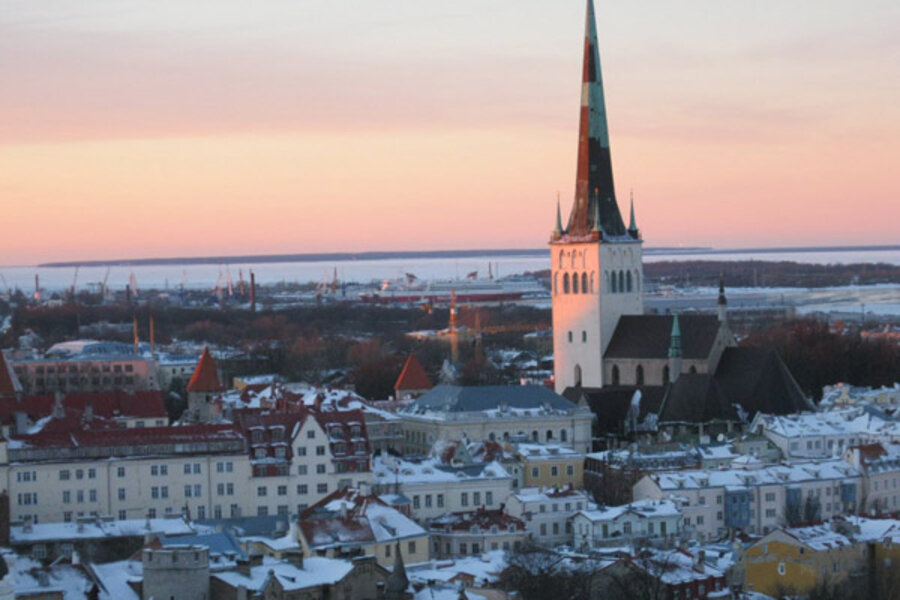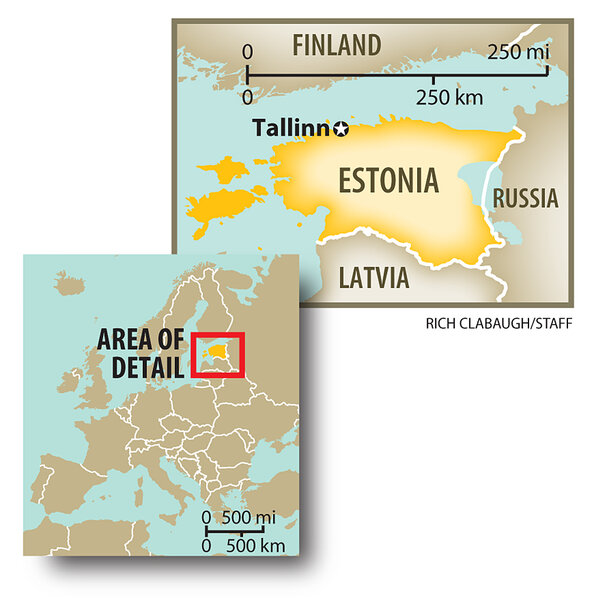Why Estonia may be Europe's model country
Loading...
| Tallinn, Estonia
An 82-foot-high billboard wrapping Estonia's finance ministry building in its capital, Tallinn, boasts: "The euro, my money." It stands just blocks from the city's cobbled, winding medieval streets and baroque churches, in a downtown where skyscrapers have replaced Russian bunkers, as a symbol of Estonia's transformation from poor Soviet republic to the European Union's rising star.
When Estonia was accepted into the eurozone in January, seven years after joining the EU and two decades after the fall of the Soviet Union, it was another big step for the small Baltic nation away from its imposing neighbor to the east, Russia.
Over the next five years, it's expected to have Europe's fastest-growing economy. It emerged from the global financial crisis wounded, but has rebounded after adopting austere measures few other countries would accept. It's given the world Skype and the only national volunteer cyberarmy, and is adding to the EU a rare sense of determination at a time when pessimism about the euro prevails – a consequence of the debt crises that have hit Greece, Ireland, and Portugal and the bailout plans that followed. Indeed, Estonia, which is still the eurozone's poorest country, has emerged as the darling of its beleaguered union. [Editor's note: The original version incorrectly stated that Estonia is the poorest European country. It is the poorest eurozone country.]
"We are very poor but very optimistic," says Jürgen Ligi, Estonia's earnest finance minister, sitting in a sparse office under a portrait of Estonian President Toomas Hendrik Ilves. Mr. Ligi, a dedicated triathlete, brings a rigid sense of discipline to his office. In many ways, he's been the chief overseer of Estonia's aggressive capitalism – flat tax rates and no corporate income tax on reinvested profits. That's been paired with cost-slashing austerity: pension cuts, reductions in benefits for civil servants, shortened maternity leaves, and even streetlights that don't stay on as long.
But in Estonia, where most remember the harsh lives under the USSR (roughly 10 percent of its population was deported to Siberian gulags), those cuts haven't resulted in any major public outcry. "We have seen much harder times," says Ligi.
In fact, Estonians overwhelmingly supported their government's austerity measures: In March they reelected the government of Prime Minister Andrus Ansip, making him the first post-Soviet era prime minister to win a second term.
The Estonia example shows that "it is possible to undertake serious fiscal adjustment in a short period of time, and be popular," says Anders Aslund, senior fellow at the Peterson Institute for International Economics in Washington. "When you do what you have to do – cut expenditures and have a clear aim of your policy – you get reelected."
Estonia's fast break from communism
Estonians benefit from emerging from the Kremlin's yoke without the ethnic and political turmoil that has weighed down other post-Soviet states. When it broke free of communism, it started over with a crop of young entrepreneurs and idealistic leaders. "Because we started anew, we got new laws, new leaders, and new technology," says Jaan Tallinn, one of the founders of Skype, the Internet phone company that was recently sold to Microsoft for $8.5 billion. "The big winners were the start-ups."
Skype got its start in a grim Soviet-era complex on the outskirts of Tallinn, where the USSR secretly assembled its first computer. Mr. Tallinn credits a spirit of entrepreneurship and creativity that filled Estonia in the 1990s, giving rise to a spirited community of computer developers. "If you happen to start a new country in the 1990s, you have the advantage of drafting new laws with the knowledge that the Internet is out there," says Tallinn.
Estonia's early adoption of the Internet has turned it into one of the world's most wired countries (it's often called e-Stonia). There's free wireless Internet at almost every street corner. People pay their parking tickets with their cellphones and voters cast their ballots digitally – the first people to do so in the world.
"The Internet and [information technology] infrastructure is a way of life," says Linnar Viik, intellectual capital theory professor at the Estonia IT College. "This way of life and the values of this society aren't controlled by state ministries of defense. They are supported by culture, education, the economy."
A cyberarmy rises
In January, Estonia deployed its volunteer cyberarmy, the 60-member Cyber Defense League. It's Estonia's electronic National Guard. Created in the wake of a massive 2007 hacker attack, which was blamed on Russian hackers (but never officially proven), the online watchdogs have turned Estonia into the model for defending against computer warfare. To make sure cyberexperts are available in case of an emergency, it is contemplating making service in the Cyber Defense League part of a national draft.
Estonians express an almost instinctive sense of national duty, something that many say stems from decades of painful occupation. "The concept of independence is fragile and sensitive and important in Estonia," says Mr. Viik.
From atop the Tallinn citadel of Toompea, a former Baroque palace that now houses the Estonian Parliament, one gets a good view of medieval Tallinn, encircled by towering walls. The city built it high under Swedish rule in the 1600s to protect itself from invaders. For more than 500 years, this forested country – the size of New Hampshire and Vermont combined – was up for grabs.
Nation after nation – Denmark, Sweden, Germany, Russia, the Soviet Union – had a turn at domination. Only once in those 500 years, from 1920 to 1940, did Estonians consider Tallinn their own capital.
"War and occupation and Stalinist terror is what really influenced the attitudes," says Olaf Mertelsmann, professor of contemporary history at the University of Tartu in Estonia. "This is why independence is sometimes glorified."
Estonia's challenges
To be certain, Estonia has a long road ahead. The latest global economic crisis hit hard. One in 10 people is unemployed. One-fifth of the population lives in poverty, and tensions remain high with the 300,000 ethnic Russians – one-third of the population – living in Estonia. How to integrate them remains a quandary. Yet Estonia does not want to spend its way to prosperity.
"Conservatism has always been a common feature for us," says Ligi, the finance minister. By the end of 2010, its budget deficit dropped to 1.7 percent of gross domestic product, well below the EU's 3 percent limit. (By comparison, Ireland and Greece had deficits of more than 14 percent of GDP.) Estonia's economy is predicted to grow by 5 percent this year.
"In many ways," says Professor Mertelsmann, "it is the West that has to learn from the East, and not the other way around."






